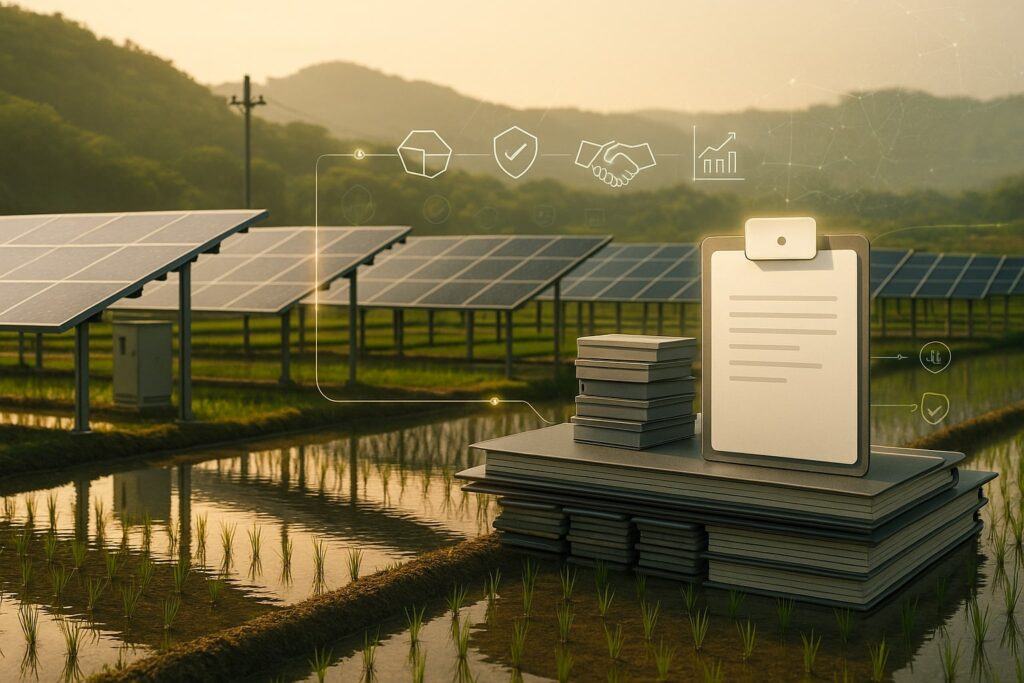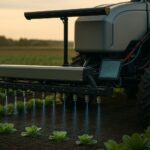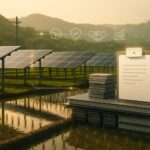Seoul is moving to normalise “solar-over-crops” with a special law drafted this year and targeted for enactment in H1 2026. The real unlock is legal tenure on farmland—and what that does to collateral, lending and insurance.
Table of Contents
ToggleWhat just happened
South Korea’s Ministry of Agriculture, Food and Rural Affairs (MAFRA) says it will draft a special act for agrivoltaics this year and push for enactment in the first half of 2026, following minister-level consultations with farmers and developers at a demonstration site in Ochang, Cheongju. In plain terms: the government intends to put “solar-over-crops” on a clear legal footing nationwide rather than leaving it in pilot status.
The ministry has already telegraphed how it will frame the rules: prevent over-development, protect food security, and ensure profits flow back to residents, co-operatives and farmers—using rural spatial plans to decide where systems belong. Officials also emphasise that agrivoltaics is still in a pilot phase pending legislation, urging the media not to over-speculate.
Why it matters: tenure turns into bankability
Today, most Korean agrivoltaics depend on a short “temporary other-use” permit on farmland—typically capped at eight years—which is too brief for project finance. The government’s pathway extends that use period to 23 years and aligns projects with “renewable-energy districts” under rural spatial planning. That one change transforms cash-flow duration, widens debt tenor options, and lowers the cost of capital.
MAFRA’s own briefing cites Korean Rural Economic Institute analysis that 20+ years of operating life is required to clear profitability hurdles—hence the push beyond the eight-year cap. The same memo also flags a governance layer: protect tenant farmers (who work a large share of Korea’s fields) through participation and revenue-sharing rules.
Investor read-through: a legally defined, 20-plus-year permission on protected farmland looks, to lenders, much closer to a concession than a pilot. Expect higher loan-to-value ratios, cheaper coverage for construction and operating risk, and a pipeline of “retrofit” farm sites that suddenly pencil.
The legal architecture in brief
Three levers sit at the core of the reform:
- A special act to define agrivoltaics, set operating and monitoring duties, hard-wire profit-sharing, and establish sanctions for non-compliance. The ministry has publicly committed to draft in 2025 and seek passage in H1 2026.
- Farmland Act amendments to extend the allowable “other-use” period from 8 to 23 years, with alignment to renewable-energy districts under the Rural Spatial Reorganization framework—clustering projects rather than scattering them.
- Opening up sensitive zones—carefully. Historically, installations were steered outside agricultural-promotion areas; the new approach contemplates tightly managed deployment and district-level planning so agrivoltaics can exist where food production is concentrated, subject to safeguards.
Enforcement will be digital—and strict
The ministry has trailed a compliance model that uses monthly aerial/imagery checks to flag plots where farming obligations are being neglected, with stepped penalties up to 5× fines and removal for repeated violations. This is not a “set-and-forget” revenue scheme; it is agriculture-first with measurable duties attached.

Does it hurt yields? The agronomy signal so far
Korean field work points to a nuanced picture in which design, crop and microclimate dominate outcomes—not a simple “yield down” story.
- A 2024 peer-reviewed study of vertical agrivoltaics in rice found no significant yield penalty over two seasons relative to open-field controls; year-to-year weather variation mattered more than the panels.
- Earlier Korean trials across multiple crops showed forage yields (rye, maize) were statistically unchanged under well-designed APV layouts.
- International guidance now treats ground-cover ratio (GCR), panel height/spacing and light distribution as the key levers, with policy often capping shading intensity and requiring active farmer participation to keep agriculture primary.
Bottom line: layout and crop choice—not headlines—decide outcomes. Expect Korea’s eventual rulebook to encode these design metrics.
The finance story most coverage missed
The headline is legislation, but the mechanism is land classification:
- From pilot to asset class. An 8-year permit is equity-heavy and expensive; 23 years supports non-recourse debt, creates refinance options, and allows insurers to price multi-decade O&M and weather risk rationally.
- Collateral clarity. Clean rules on who may operate (farmer-led entities, co-ops) and how profits are shared with tenants reduce disputes that would otherwise trigger covenant breaches or claims.
- Spatial planning = lower soft costs. District-level siting consolidates interconnection studies, environmental review and community engagement—shaving months off timelines and soft-cost stacks, as seen in European frameworks.
For developers, the model shifts from “chase variances” to “follow the district map.” For banks, that means underwriting process risk rather than political caprice.
Who stands to benefit
- Farmer co-ops and farm-led SPVs. The policy direction explicitly centres farmers as project principals, with tenant participation to avoid rent shocks—exactly the structures most acceptable to local lenders and communities.
- EPCs with agronomy credibility. Rules that prioritise farming performance reward integrators who can tune GCR, row height and module choice to specific crops and mechanisation needs.
- Institutional capital. Longer tenure and district planning produce portfolios that can be warehoused and securitised once operating data accumulates.
What to price into your model (Korea-specific)
- Tenure: move from 8 to 23 years as the working base case; stress at 18–20 in downside scenarios given legislative and by-law risk.
- Farming obligations: include compliance OPEX—imagery, inspections, agronomic record-keeping—and revenue-sharing with tenants or local entities.
- Design constraints: assume caps on shading/GCR and minimum clearances to accommodate machinery; these are increasingly standard in mature markets and flagged in global guidance.
- Where you can build: plan inside renewable-energy districts; outside them, expect higher friction or delays.
Context: how Korea got here
Over the past 18 months Korea has been loosening aspects of farmland regulation and clarifying rural-planning tools, while signalling that agrivoltaics must protect high-quality farmland and channel gains locally. The April 2024 strategy paper explicitly proposed the 23-year permit for non-promotion farmland and previewed the district approach; subsequent memos and press briefings in October 2025 formalised the legislative path and tenant-protection themes.
The risks to watch
- Food-security politics. Opening the door in promotion zones will remain sensitive; opponents will cite long-run erosion of core farmland. Clear agronomic standards and strict monitoring will decide legitimacy.
- Grid access. Districts should reduce soft costs, but Korea’s interconnection queues can still bottleneck distributed projects; sequencing will matter. (Global guidance highlights how design rules trade off PV yield and farm performance.)
- Execution burden on farmers. Compliance overhead—data logs, imagery checks—must be service-wrapped, or smallholders will opt out.
The punchline
If Seoul does what it says—codify long-tenure, farmer-centred agrivoltaics, with revenue-sharing and hard-edged enforcement—the asset class becomes financeable at scale. The panels were never the constraint. Land classification and tenure were. Korea is about to change both.




